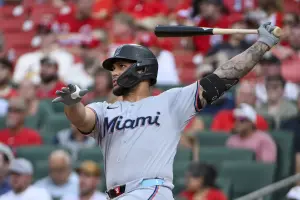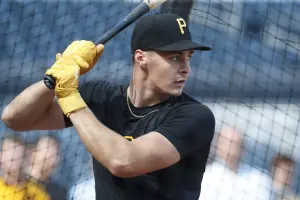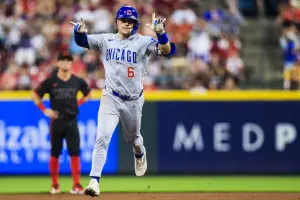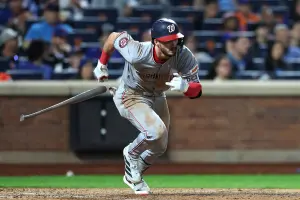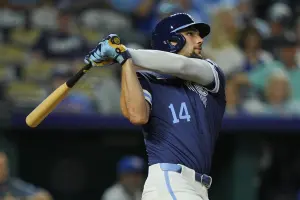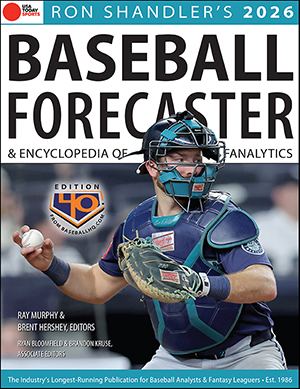
(*) ROTISSERIE: Pinch-Drafting in NL Tout Wars
“Now batting…pinch hitting for Phil Hertz….Number 7…Dave…Adler…”
What do you do when a league requires in-person attendance…but life gets in the way, and you can’t make it? You get a pinch-drafter, of course. The expert-league fun-fest known as Tout Wars occurred in New York City last weekend, and long-time NL-only stalwart Phil Hertz could not make it due to previous commitments. Since I can get into the bright lights of the big city easily, I volunteered to take his place at the auction table. Phil will continue to helm the team during the season.
Elements of Style
The first step of pinch-drafting, of course, is to define the starting point – the projected stat database. We’re both BaseballHQ writers, and prefer to heed Mayberry reliability scores, so no issues in this case. But make sure you’re on the same page as your designated picker before getting started. Since projected stats inherently involve uncertainty, discuss how closely to follow them (and the projected dollar values) before getting into the heat of auction battle.
Which, of course, brings up the next question – what’s your auction style? In general, I don’t target specific players - I set a budget for each position and identify acceptable players that fall in those tiers (see my AL-LABR article for a recent run with this process).
Phil takes a different approach, creating three levels of players and targeted salaries, the first being the “ideal outcome.” The projected salaries of that level adds up to $260, so I immediately had my first set of targets to enter into RotoLab. Phil followed that up with second and third player levels that should be targeted if the first-level players don’t work out for some reason. After marking those players with different labels, I had a set of well-defined targets/salaries to take into the auction.
To be prepared, I also identified lower-level ($1-2) players to fill in gaps in the end-game.
How flexible is flexible?
Like John “Hannibal” Smith, I love it when a plan comes together. But it helps to know how much price flexibility exists? It’s great to have a list of target players/salaries, but you never know how an auction will flow until it begins. And, of course, players in the second and third levels from Phil’s lists are likely to come out before some of the players in the first level. So I had Phil specify the flexibility for both the players and the target salaries. I got the OK to go up to a few dollars for the first-level players, and, unless auction dynamics dictated it, not to go over value on the second and third levels.
Know the league
It seems obvious, but make sure you understand the scoring categories and rules in the league. Tout has some wrinkles that need to be considered – for instance, it’s an OBA league, rather than BA. There’s also a “swing-man” in place of an outfielder; that slot can be used as a hitter or pitcher in the weekly lineup. Finally, there’s no minimum innings requirement, which opens all sorts of strategy implications.
A big question for the pinch-drafter – do you know the other owners in the league? If not, get the inside scoop from your compatriot. While it’s my first time in Tout for many years, I participate in leagues with many of the other folks in NL-LABR; Phil filled me in on most of the rest. However, there are two new owners in the league, and neither Phil nor I knew their style. Another factor – Brian Feldman, the auctioneer, also did AL-LABR two weeks ago, so I’m used to his fast-paced style.
General Strategy
Phil and I decided to spread the risk, and other than one target, spend $30 or less on each player. His lists leaned heavily towards players with high Mayberry reliability scores, although some exceptions were made. Phil’s goal for pitching - limit it to $60-65. After LABR, I felt that wouldn’t be enough for a competitive staff, so planned on $70-75. He wanted one of Josh Hader or Devin Williams as closer for under $20, but having seen them go in the lower $20s in NL-LABR, I planned to go over $20 to secure one of those two.
The team
Things seemed to go well. Here’s the team:
Pos Name Team MM CODE Sal $R === =============== ==== ======== === == C Bart, Joey SFG 3104 ADA 6 4 C Narvaez, Omar NYM 1013 BBD 4 1 1B Alonso, Pete NYM 4155 AAA 35 30 3B McMahon, Ryan COL 3235 AAB 18 16 CO Escobar, Eduardo NYM 3143 AAC 4 11 2B Stott, Bryson PHI 2435 ABA 11 13 SS Abrams, C.J. WAS 1525 ACB 16 13 MI Kim, Ha-Seong SD 2435 AAC 14 13 OF Bryant, Kris COL 4245 FCC 21 20 OF Happ, Ian CHI 4235 AAB 19 18 OF Conforto, Michael SFG 4245 BFD 15 19 OF Suwinski, Jack PIT 4105 ABA 4 11 UT Grichuk, Randall COL 3235 AAB 7 14 SW Robles, Victor WAS 1413 ABA 4 5 SP Greene, Hunter CIN 3503 DCB 18 17 SP Lodolo, Nick CIN 4503 DDA 14 13 SP Rogers, Trevor MIA 3303 DBA 9 9 SP Keller, Mitch PIT 2203 BBC 4 8 RP Williams, Devin MIL 5530 BCC 23 15 RP Gallegos, Giovanny STL 3510 BBA 6 7 RP Suarez, Robert SD 4410 DAD 2 4 RP Lugo, Seth SD 3301 DCA 5 6 RP Vesia, Alex LAD 4510 ADF 1 5 RES Strzelecki, Pete MIL 5500 AFF 0 3 RES Bush, Matt MIL 4410 FFFF 0 1 RES Toro, Abraham MIL 3233 ACD 0 4 RES Toglia, Michael COL 2303 ACA 0 0
How it went
Tough crowd. As typical in leagues with experienced players, bargains didn’t really exist in the first part of the auction; the early stars routinely went for $1-5 over projected value. The bargains came later in the auction, where the mid-tier went for a little less than projected. I spent more than projected on pitching; as the auction progressed, that seemed the best place to spend the dwindling payroll.
In general, I rostered the tiered players Phil wanted, albeit for a buck or two more than he had aimed. As he noted after the auction: “I wanted one of the four top first baseman and felt that Alonso would be the best bargain (my note: unfortunately not a bargain!), keeping in mind the Forecaster’s up note: .283, 50 homers. On the pitching side, I wanted a top closer: either Devin Williams or Josh Hader. There were last minute concerns that Edwin Díaz’ injury would push their cost up, but in the end, the ultimate price of $23 was tolerable. I also decided I didn’t want to pay for one of the ‘elite’ starters and instead successfully targeted Hunter Greene. Once again, the Forecaster UP - 3.00 ERA, 220 Ks - played a role in the decision making.”
Looking at the RotoLab projections – the team is well set up for runs and power, appears to be middle of the road for speed, and lacks OBA prowess. Pitching looks to be in the top half of the league in most categories but lacks wins.
Conclusion
The main take-away from last weekend – with good communication, and keeping an eye on reliability, this pinch-drafter took Phil’s vision and turn it into a competitive team. I leave it in Phil’s hands to get the squad to cross the finish line first!


